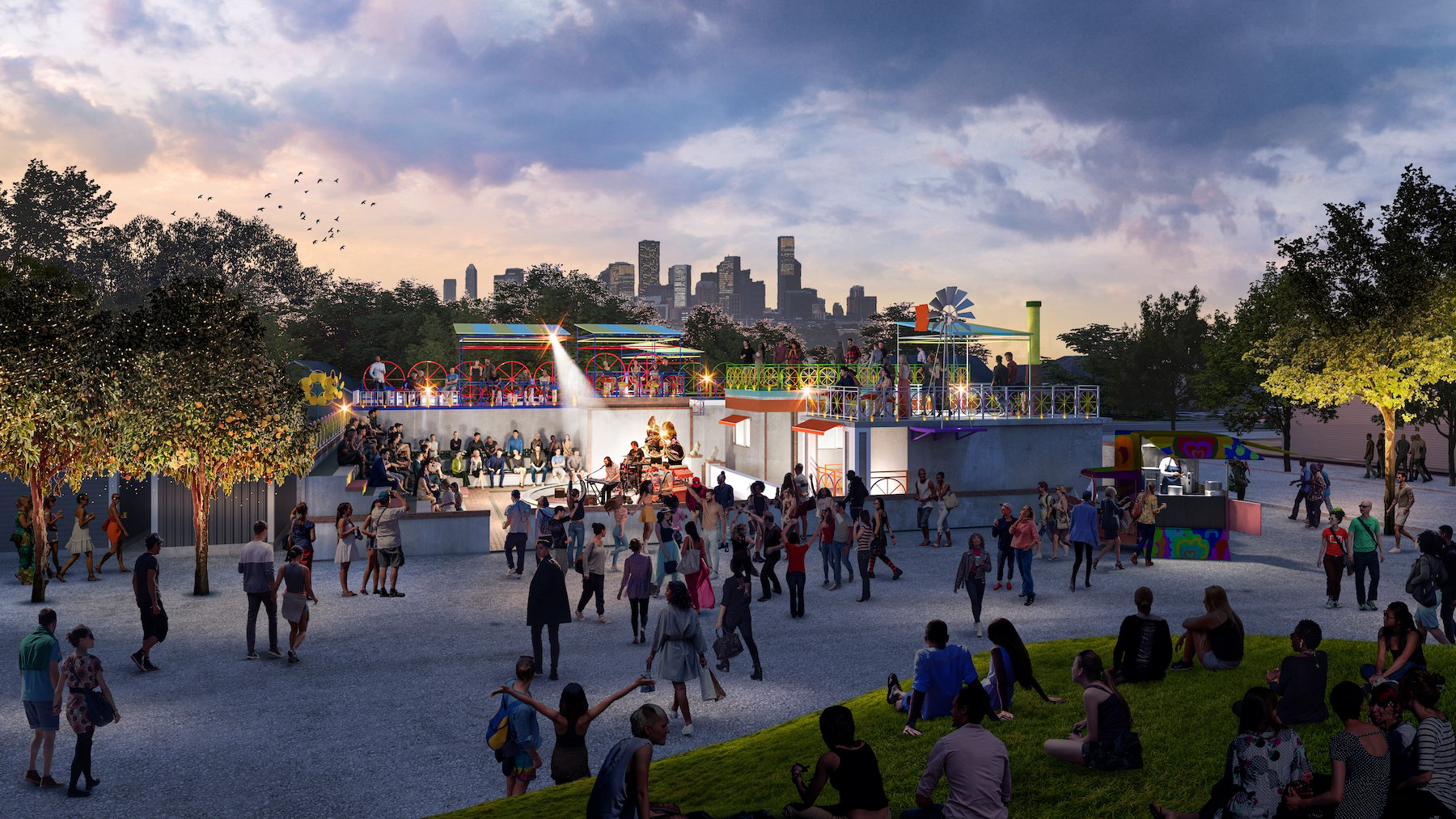
For 40 years, Houston’s Orange Show Center for Visionary Art has been the guardian of experiential art environments in the city. Now, for the first time, the nonprofit organization is building a central campus with a permanent gallery that will unite two of its three spaces.
“The expansion will allow us to provide a dedicated built environment where visitors’ understanding of what constitutes art or who can identify as an artist is challenged,” executive director Tommy Ralph Pace told Artnet News.
The ambitious project, which is tentatively scheduled to be completed in 2026, is possible thanks to the 2017 purchase of a 5.7-acre disused industrial lot for $1.9 million. (The organization has yet to share projected costs for the expansion, other than that they will reach the tens of millions.)
Architectural firm Rogers Partners will transform an existing concrete industrial pallet warehouse, a 31,000-square-foot building from the 1950s, into a flexible, three-story performance and exhibition space for self-taught and so-called Outsider art. There will also be an 800-foot ramp that runs the length of the campus.
Tommy Ralph Pace, executive director of the Orange Show Center for Visionary Art, Houston. Photo: Xavier Lujan.
“It’s meant to be activated by guests as a promenade,” Pace said. “We’re looking for the campus to be an opportunity for our community to engage in the creative process. And we want to mobilize our community to contribute to the creation and the preservation of experiential art environments.”
The organization takes its name for its first site, the Orange Show Monument, a folk-art environment resembling a mini amusement park, hand-built by Jefferson Davis McKissack, a Houston postal worker between 1956 and 1979. When he died the following year, local arts patron Marilyn Oshman was determined to preserve his unique creation. To that end, she formed a foundation and enlisted supporters, including art collector Dominique de Menil and members of the Texas rock band ZZ Top.
The Orange Show Monument. Photo courtesy of the Orange Show Center for Visionary Art, Houston.
In the years that followed, the Orange Show Center grew to include Smither Park, a collaboratively created mosaic park featuring the work of more than 300 local and regional artists, and began hosting the now 35-year-old Houston Art Car Parade. The organization’s third site is the Beer Can House, a 20-year project by John Milkovisch, a retired upholsterer for the Southern Pacific Railroad who, beginning in 1968, covered his home with over 50,000 beer cans.
The new campus connects the Orange Show Monument and Smither Park, and will allow for the permanent exhibition of significant Houston Art Car Parade vehicles for the first time. It will total eight acres, abutting the existing Fonde Park to create an extended green space that connects to the Bayou Greenways trail.
“We believe we’ll have huge local attendance,” Pace said. “And with Houston being one of the leading centers for the exhibition and presentation of visionary art, self-taught art, and quote-unquote Outsider art, we’re excited to come onto the landscape in a national way as well.”
See more photos and renderings from the organization below.
An art car in the Houston Art Car Parade. Photo: Morris Malakoff. Courtesy of the Orange Show Center for Visionary Art, Houston.
An art car in the Houston Art Car Parade. Photo: Morris Malakoff. Courtesy of the Orange Show Center for Visionary Art, Houston.
The Fruitmobile in the Houston Art Car Parade. Photo courtesy of the Orange Show Center for Visionary Art, Houston.
Jefferson Davis McKissack and Marilyn Oshman in front of the Orange Show Monument. Photo courtesy of the Orange Show Center for Visionary Art, Houston.
An art car in the Houston Art Car Parade. Photo courtesy of the Orange Show Center for Visionary Art, Houston.
An art car in the Houston Art Car Parade. Photo courtesy of the Orange Show Center for Visionary Art, Houston.
The Button King’s art car in the Houston Art Car Parade. Photo courtesy of the Orange Show Center for Visionary Art, Houston.
Reagan High School’s Art Car Parade entry, Bohemian Rhapsody, at the 2016 Houston Art Car Parade. Photo: Elizabeth Conley for the Houston Chronicle. Courtesy of the Orange Show Center for Visionary Art, Houston.
The Beer Can House. Photo courtesy of the Orange Show Center for Visionary Art, Houston.
The Orange Show Monument. Photo courtesy of the Orange Show Center for Visionary Art, Houston.
John Milkovisch at his home, the Beer Can House. Photo: Janice Rubin. Courtesy of the Orange Show Center for Visionary Art, Houston.
Rendering of the Orange Show Center for Visionary Art’s future entrance and ramp. Courtesy of the Orange Show Center for Visionary Art, Houston, and Rogers Partners.
Rendering of the future aerial view of the Orange Show Center for Visionary Art Campus and Fonde Park extension. Courtesy of the Orange Show Center for Visionary Art, Houston, and Rogers Partners.
Rendering of Mosaic Alley at the future Orange Show Center for Visionary Art Campus and Fonde Park extension. Courtesy of the Orange Show Center for Visionary Art, Houston, and Rogers Partners.
Rendering of the art car experience at the future Orange Show Center for Visionary Art Campus. Image courtesy of the Orange Show Center for Visionary Art, Houston, and Rogers Partners.
Rendering of an exhibition in the future Orange Show Center for Visionary Art warehouse. Courtesy of the Orange Show Center for Visionary Art, Houston, and Rogers Partners.